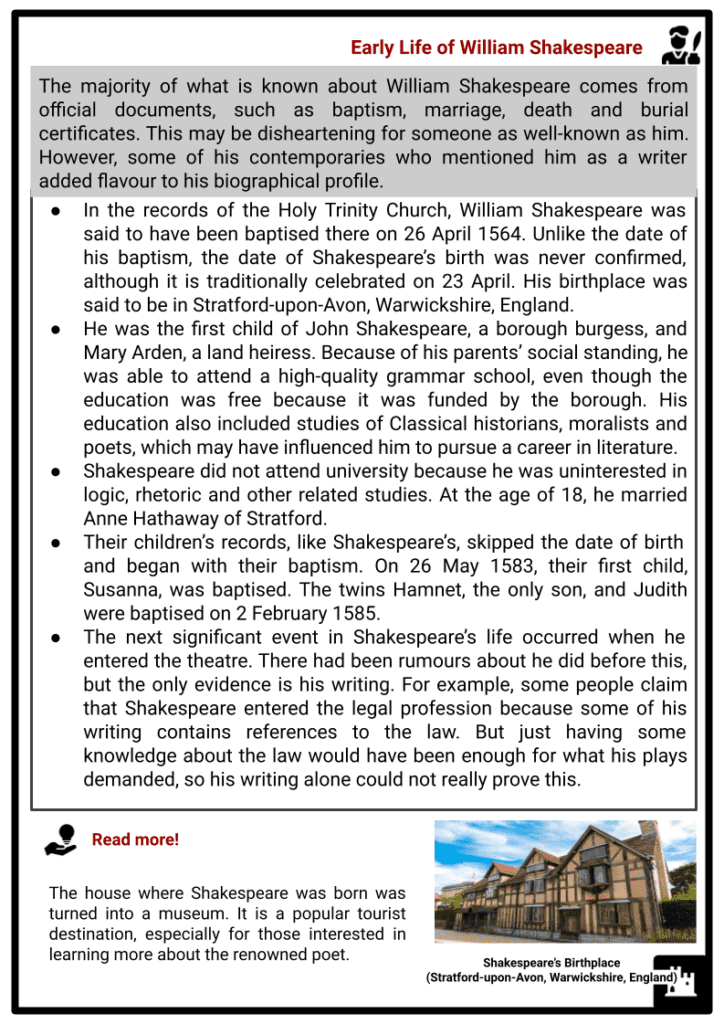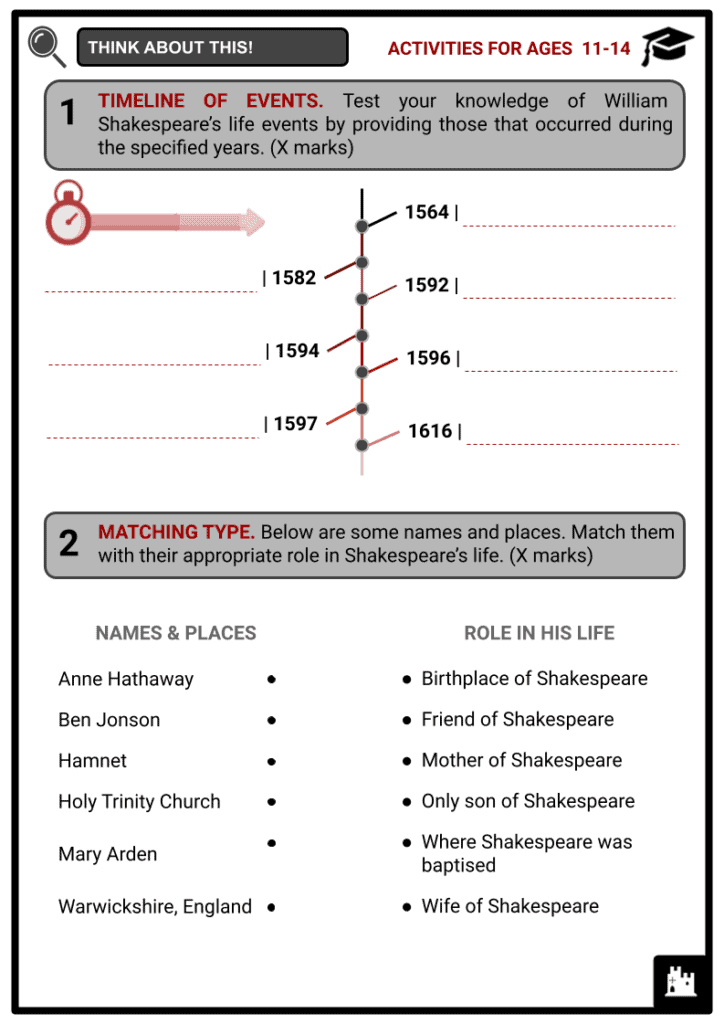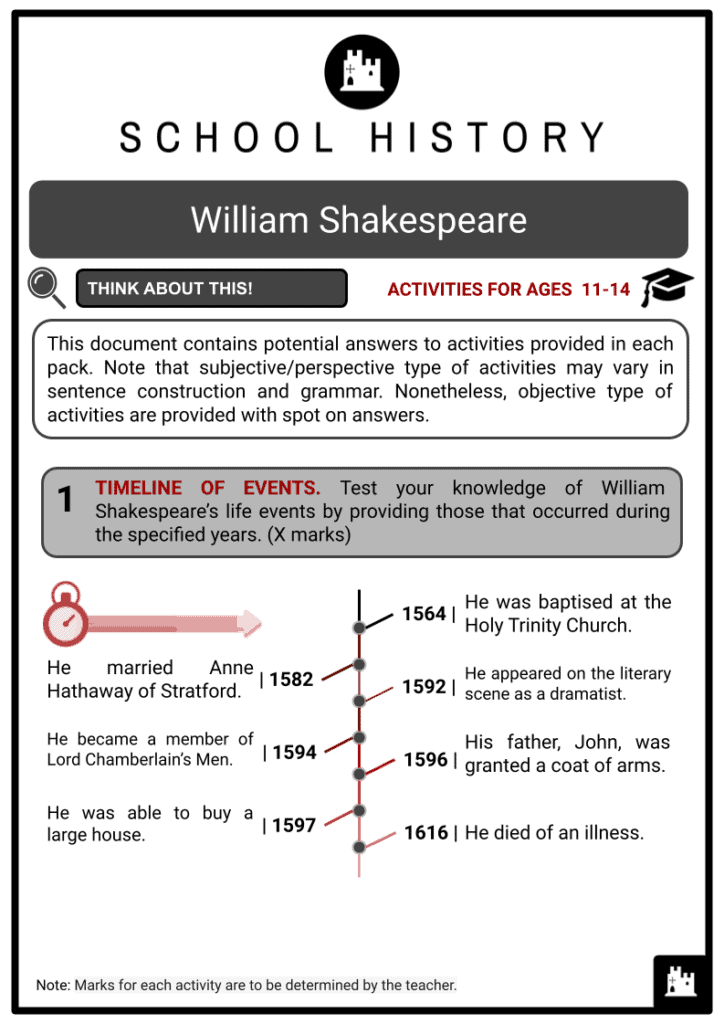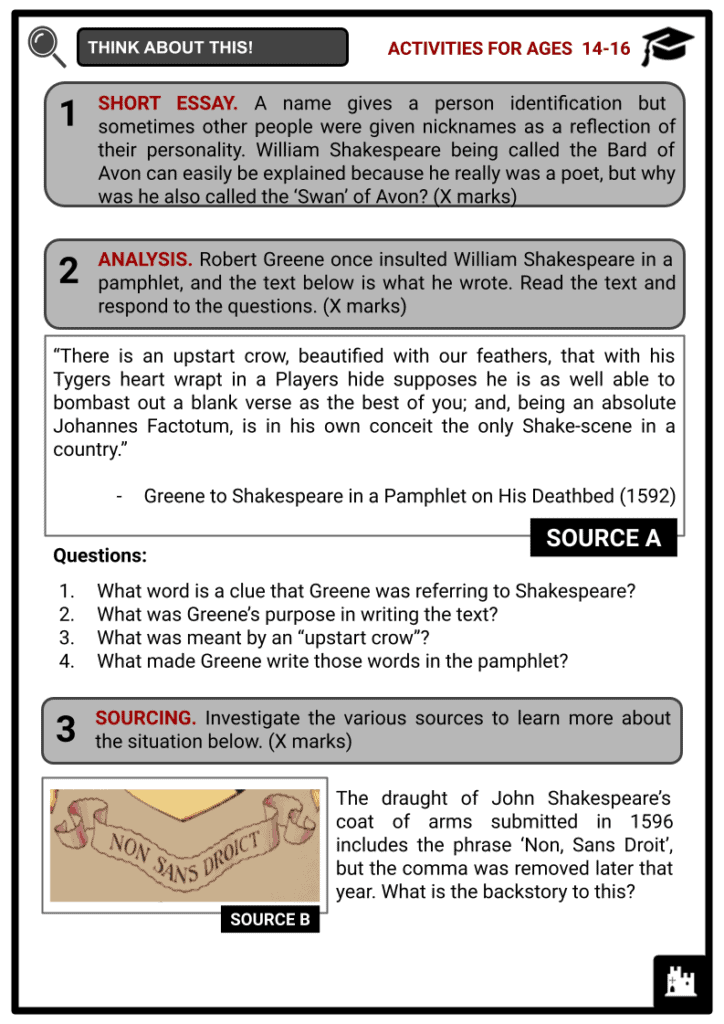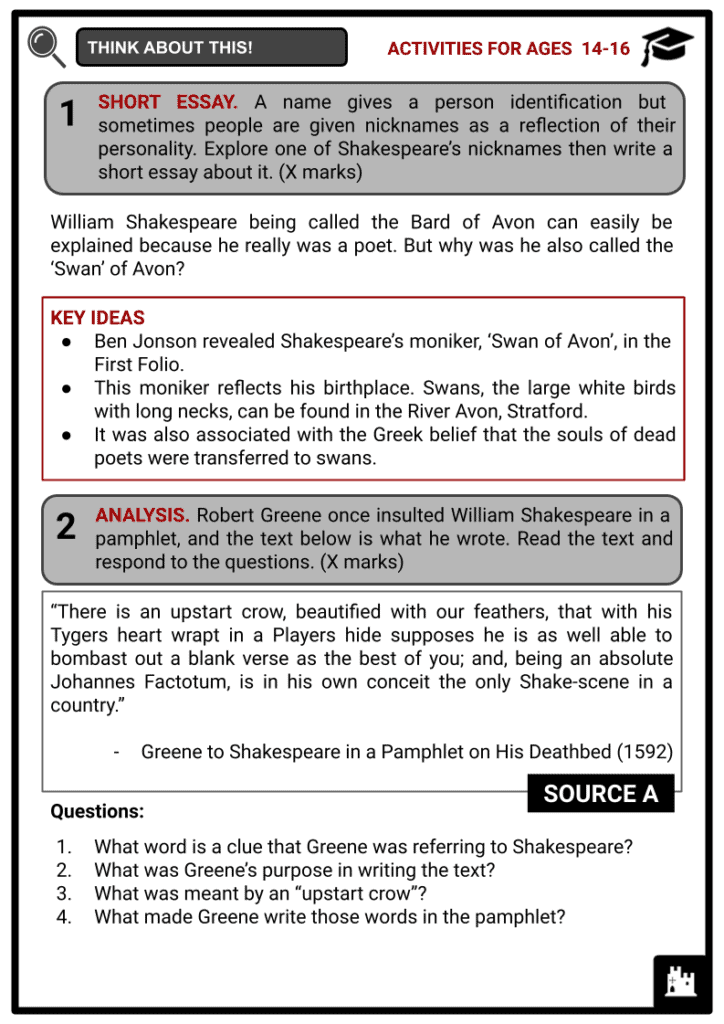William Shakespeare Worksheets
Do you want to save dozens of hours in time? Get your evenings and weekends back? Be able to teach about William Shakespeare to your students?
Our worksheet bundle includes a fact file and printable worksheets and student activities. Perfect for both the classroom and homeschooling!
Summary
- Early Life of William Shakespeare
- Shakespeare’s Career in Theatre
- Notable Works by Shakespeare
- Contemporaries of Shakespeare
Key Facts And Information
Let’s find out more about William Shakespeare!

William Shakespeare, also known as the Bard of Avon or the Swan of Avon, is one of the greatest and most famous authors of all time. As a testament to his writing prowess, he is frequently referred to as the National English Poet. Shakespeare, like other great poets such as Homer and Dante, surpassed national boundaries. Furthermore, he and his literary works were admired not only by people of his time but also by people of today. His intellect was largely reflected in his works, which is one of the reasons many people of various nationalities and ages admired his writing abilities. His most famous works include Romeo and Juliet and Hamlet. Shakespeare’s literary works served as more than just reading material; they also served as inspiration.
Through his works, William Shakespeare popularised the names Cordelia, Jessica, Miranda, and Olivia as they are spelt today.
Early Life of William Shakespeare
- The majority of what is known about William Shakespeare comes from official documents, such as baptism, marriage, death, and burial certificates. This may be disheartening for someone as well-known as him. However, some of his contemporaries who mentioned him as a writer added flavour to his biographical profile.
- In the records of the Holy Trinity Church, William Shakespeare was said to have been baptised there on 26 April 1564. Unlike the date of his baptism, the date of Shakespeare’s birth was never confirmed, although it is traditionally celebrated on 23 April. His birthplace was said to be in Stratford-upon-Avon, Warwickshire, England.
- He was the first child of John Shakespeare, a borough burgess, and Mary Arden, a land heiress. Because of his parents’ social standing, he was able to attend a high-quality grammar school, even though the education was free because it was funded by the borough. His education also included studies of Classical historians, moralists, and poets, which may have influenced him to pursue a career in literature.
- Shakespeare did not attend university because he was uninterested in logic, rhetoric, and other related studies. At the age of 18, he married Anne Hathaway of Stratford.
- Their children’s records, like Shakespeare’s, skipped the date of birth and began with their baptism. On 26 May 1583, their first child, Susanna, was baptised. The twins Hamnet, the only son, and Judith were baptised on 2 February 1585.
- The next significant event in Shakespeare’s life occurred when he entered the theatre. There had been rumours about what he did before this, but the only evidence is his writing. For example, some people claim that Shakespeare entered the legal profession because some of his writing contains references to the law. But just having some knowledge about the law would have been enough for what his plays demanded, so his writing alone could not really prove this.
- The house where Shakespeare was born was turned into a museum. It is a popular tourist destination, especially for those interested in learning more about the renowned poet.
Shakespeare’s Career in Theatre
- Shakespeare first appeared on the English literary scene as a dramatist in 1592. He had become the target of Robert Greene’s sarcasm, which a mutual acquaintance apologised for in a written preface after Greene’s death.
- There is no clear documentation of Shakespeare’s beginnings as a dramatist. However, he appeared to have been a vital member of the Lord Chamberlain’s Men, an English theatrical company, since 1594. Since the company had the best actor, Richard Burbage, and the best theatre, the Globe Theatre in London, it’s no surprise that the theatre company prospered.
- Shakespeare worked full-time for the theatre company, and he was most concerned with the financial rewards he would receive from the success of the plays he wrote.
- One indication of his success is that his father, John Shakespeare, was granted a coat of arms in 1596, while William initiated the grant and willingly paid the fees. The said coat of arms is now displayed on Shakespeare’s monument, which was built before 1623 in Stratford church.
- In 1597, Shakespeare’s successful career in the theatre enabled him to buy a large house, which as a boy, he had often passed when walking to school.
- He fully committed around 20 years to writing millions of words of high-quality poetic dramas.
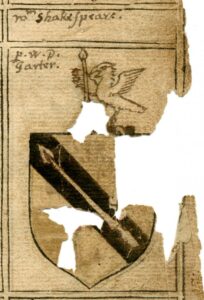
- Heather Wolfe, a Folger Curator of Manuscripts, was said to have made discoveries about the Shakespeare coat of arms in a blog written by Esther French on 5 July 2016. This revealed that, in addition to his father’s recorded grant of a coat of arms, William Shakespeare also received one for himself. “It shows him shaping himself and building his reputation in a very intentional way,” Wolfe said.
- The Shakespeare coat of arms (shown on the left) is designed as a shield with a diagonal black bend containing a spear and a falcon with a spear on top of the shield.
Notable Works by Shakespeare
- Shakespeare, widely regarded as the greatest dramatist of all time and the most influential writer, had a significant impact on the field of literature. He coined hundreds of words and phrases that are still used by English speakers today. His literary works are numerous, but the following are the most notable.
- Romeo and Juliet (c. 1594-1596)
Romeo and Juliet is a story about two young lovers, each from a wealthy family, who are prevented from living happily ever after. Although the play is tragic, its impact was not. It has been adapted numerous times for stage and screen in various countries up to the present day.
- Much Ado About Nothing (c. 1598-1599)
Much Ado About Nothing is a comedy play about a woman named Hero who is falsely accused of infidelity by her partner, Claudio. The plot features entertaining miscommunications, witty insults, and scepticism about love.
- Julius Caesar (c. 1599-1600)
Julius Caesar is a play about Caesar, the Roman Emperor. Caesar is betrayed by his allies and a trusted friend, Brutus. This is where the famous phrase ‘Friends, Romans, countrymen, lend me your ears’ came from.
- Hamlet (c. 1599-1601)
Hamlet is widely regarded as the greatest drama ever written. Hamlet is the Prince of Denmark, and he is dealing with the problems of his father’s death and his mother’s new husband, who happens to be his father’s brother and successor.
- King Lear (1605-1606)
King Lear, on the other hand, differs from Shakespeare’s usual tragic plots in that it is optimistic. In this play, he represented hope in the character of Cordelia, who is disinherited by her father, King Lear, when he divides the kingdom among his daughters. Cordelia’s character promotes moral strength even when confronted with injustice.
- Macbeth (c. 1606-1607)
The play Macbeth is about a Scottish nobleman who assassinates a reigning king named Duncan and gives him the throne after three witches read a prophecy. To maintain his power, he kills anyone who poses a threat to his position. Lady Macbeth is enraged by his murders. Finally, his political ambitions bring about his own death.
- Sonnets (1609)
Shakespeare began writing his sonnets in the 1590s, although they were first published in 1609. Some speculate that these were autobiographical sonnets about a ‘Fair Youth’ friend and a ‘Dark Lady’ who ended the sequence with sorrow and self-loathing.
- The Tempest (1611)
The Tempest was widely regarded as Shakespeare’s farewell to the stage, even though it was not his final written work. It contains depictions of his artistic abilities that drove him to achieve what he did.
Death of Shakespeare
- Despite being unconfirmed, William Shakespeare’s birth date is traditionally celebrated on 23 April. This fuels speculation that his death, on 23 April 1616, was the result of an illness brought on by a night of heavy drinking as part of his birthday celebrations with two of his contemporaries, Ben Jonson and Michael Drayton.
- At the time Shakespeare died, writing plays was not yet a serious profession. So, although he made a lot of money during his life, his funeral was not fit for a famous person.
- In 1623, John Heminge and Henry Condell compiled the plays he had written. As the First Folio, this single large-format edition became one of the most famous texts in English literature.
- Ben Jonson was confident that his friend, Shakespeare, would one day be known throughout the world, so he declared that his friend was a writer “not of an age, but for all time.” And this is exactly what happened.
- Shakespeare was later dubbed the ‘Bard of Avon’, as well as one of the greatest writers who ever lived.
- His works survived his death and are still taught, read, and performed around the world.
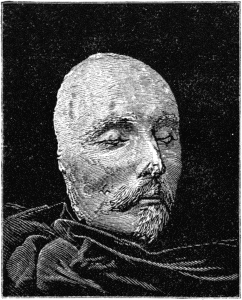
- A death mask can be kept as a memento of the deceased or used to create portraits, most commonly in Western cultures. It’s made out of wax or a plaster cast. Death masks differ only slightly from the real features of a person’s face.
- Many experts have questioned whether William Shakespeare’s death mask was his. This death mask was discovered in the 1840s in Darmstadt, Germany. Dr Caroline Wilkinson, who conducted consistency analysis on many death masks, including Shakespeare’s, backed up the mask’s consistency with existing portraits of the writer.
Image Sources
- https://www.biography.com/writer/william-shakespeare
- https://shakespearedocumented.folger.edu/resource/document/armorial-william-smith-rouge-dragon-coat-arms-william-shakespeare?_ga=2.107134081.2059749017.1647836854-1060956627.1647836854
- https://etc.usf.edu/clipart/54200/54297/54297_deathmask1.htm


